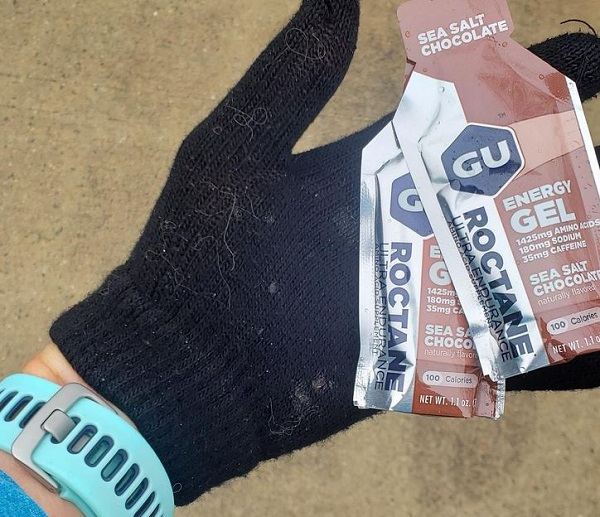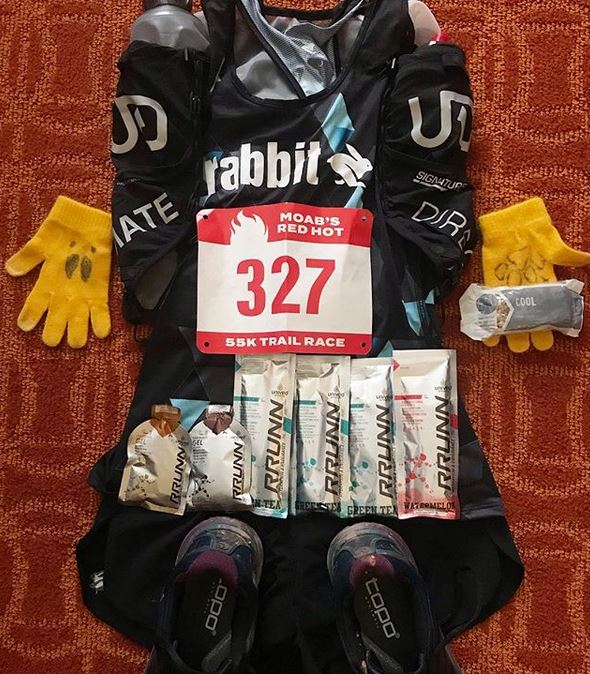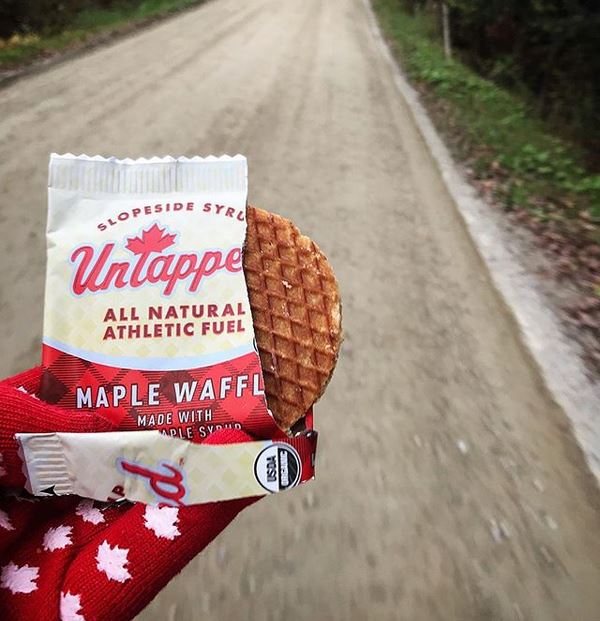The half marathon is a tricky distance when it comes to fueling. You absolutely need fuel, but how much, what type and how often depends on a number of factors; like the amount of time you’ve been running long distances or how fast you can complete the race.
For those targeting their first half marathon, knowing when to fuel, how much to eat, and what to consume can be confusing. Ok fine, even after running them for years a lot of us are still trying to figure what we need!
Having a good half marathon fueling strategy could be the final piece to hitting your next PR. I’ve seen this in so many athletes that we’ve coached over the last 10+ years. It’s the thing that helps to put your training to work.
So let’s break down some half marathon fueling questions and strategies to make it easier for us all, shall we?<
Do I Need to Fuel During a Half Marathon?
Your body relies on two primary sources of fuel to feed the muscles during long runs—fat and carbohydrates.
Since fat breaks down slowly, it’s not the most effective source of quick energy, however it’s what your body will use more on during base building and long easy runs. This is what people refer to when talking about being fat adapted.
That’s great, but DOES NOT MEAN that you don’t need carbohydrates.
Specifically when running at faster paces (or harder efforts), your body will switch from mostly fat to mostly carbs. And in a race, you want the absolute easiest and quickest form of energy available.
We can typically store about 90 minutes worth of glycogen stores (aka carbohydrates) in our muscles before it begins to deplete. Since most of us will take longer, there’s going to be a pay off for a smart race day fueling strategy.
During the half marathon taper, your body is going to build back up it’s glycogen stores from recovery and carbo loading. And this is crucial for your best race day performance! You need carbs.

When To Eat During a Half Marathon?
Step one is to ensure you’ve eaten enough prior to the race, which is covered in depth in what to eat before a race!
The most important part of half marathon nutrition is getting those calories before you actually need them. If you’re feeling low energy or have already bonked, then it’s too late and your performance will suffer.
What’s interesting is it’s less about the calories and more about telling your brain that fuel is coming! Some studies have shown even that bit of sweetness on your tongue from a sports drink can give you a boost.  Photo from @sandinypaver getting ready for an ultra.
Photo from @sandinypaver getting ready for an ultra.
- A good rule of thumb is begin consuming fuel between the first 45 minutes of a race.
- Continue every 30-40 minutes after that. (See below for gram recommendations which influences timing)
- Try and time your intake with the aid station so you can wash a gel down with water (not sports drink, that’ll be sugar overload).
Knowing when to fuel during a half marathon takes practice and learning to read your energy levels. Which is to say you need to fuel before you start hitting the wall!
Sample Half Marathon Fueling Plan
While I may not take in much during long training runs, on race day the following has worked well for many runners in the 2-3 hour finishing time:
- Start line pre-workout and or a gel
- Sipping hydration every mile or at most water stops (without hydration gels can make you feel sick and hydration is part of your fueling plan)
- 40 minutes first energy gel (trying to hit 45 grams in that first hour)
- 70 minutes second energy gel or energy chews (I like something with a little caffeine)
- Remember you can get carbs from your hydration too, making that 45 grams easier! Know what sports drink is on the course or carry your own liquid nutrition (ideas below)
- 100 minutes little bit more fuel
- Mile 11 final fuel
If that feels like a lot to you, it’s because most of us have not been fueling enough. But once you start hitting these numbers, you’ll be shocked how much better the race feels. However, YOU MUST TRAIN YOUR GUT. Practice on your long runs and even during speed workouts.
Of course this is highly dependent on a lot of factors. But remember that we want to be taking in 45-60 grams of carbohydrates per hour.
If you take 1 gel that’s 25 grams at 30 minutes, you need to take in another gel that same hour to hit your goal.
**Hilly races can be an exception because the higher your HR is shooting up, the more carbohydrates your body is burning. In those cases, I’ll actually organize my fueling around taking something a little before any of the major hills.
Remember if you eat breakfast two hours before even starting, you WILL benefit from quick carbs on the start line. You want your body to feel primed to go. As always it’s key to find what works for you. Though you may not need a ton of fuel on your training runs, try out just one or two things to see what your stomach does.
As always it’s key to find what works for you. Though you may not need a ton of fuel on your training runs, try out just one or two things to see what your stomach does.
Maybe you feel good with gels or maybe they give you an immediate stomach ache. Maybe you have a huge boost from caffeine or maybe it just makes you need to pee (and thus need caffeine free energy)!
Mid way through your race is not the time to try new foods!
What to Eat During a Half Marathon
The endurance fuel game has changed so much since companies started manufacturing them for distance athletes.
As the understanding of sports nutrition has evolved and improved, there are now infinite options available for fueling your body during long runs.
How do you even go about sorting through all the choices? For most, it’s trial and error. The right nutrition plan is the one that works for you and doesn’t give you an upset stomach.
While some prefer gels, others go with chews or whole foods. I’ve done a lot of testing to come up with the best running gels, but here’s a breakdown of the options.
Natural Energy Gels for a Half Marathon
Energy gels range from standard brands like GU to more natural options listed below. Standard gels can often lead to GI distress due to the fructose, so try several different brands to see how you feel afterward.
Your half marathon fueling strategy needs to start during training!! Go to a running store and buy individual packets to test out things, then you can buy a larger pack when you know what feels good.
A few natural energy gel favorites (of mine and those I polled) include:
Easier on the Stomach Energy Options
Chews are a great alternative for those who can’t stomach energy gels. Just keep in mind that you’ll need to practice chewing something gummy while running.
It’s not as easy as you think and 1 blok or a couple beans are not the same volume of energy as a gel (which is ideal for some, but not all!).
Practice what it feels like to chew a lot while you are doing a speed workout to know if this is a good option for you.
A few of my go to picks are:

Whole Food Running Fuels
If all the sugars in gels and chews makes your stomach revolt, whole foods might be a better option.
BUT remember that with whole foods you often need a larger quantity to hit your carb goal!
So you may need to eat more frequently to hit 45-60 grams per hour. Cyclists can get away with more whole foods because their stomachs aren’t being jostled around and ultra runners because of the lower pace and periods hiking.
- Squeeze packet of fruit puree
- Dried apricots
- Raisins (takes an entire small box to get your carbs, per hour…not that easy while racing)
- Energy bites (here are 21 easy and delicious recipes to make your own)
I’ve got an entire post on what you need to know about using whole foods for fuel, so go read that for all the details and lot more ideas!!
Are Sports Drinks Enough for Half Marathon Nutrition?
Maybe. Like gels, chews, and whole foods, sports drinks replace some of the lost glycogen stores.
In addition, the electrolytes contained in the sodium and potassium help with fluid retention lost from sweating.
If you plan to rely solely on sports drinks as your half marathon fueling strategy, then pick one with more carbs and calories. This is NOT The time to skimp on carbs or go sugar free.
One regular Nuun tablet contains just 10 calories and 1 gram of carbohydrates. While it’s great for some flavor, it’s not the best choice for fuel.
You also need sodium to help the gut handle all of the sugars.
Without replacing sodium during your race, you could end up:
- Muscle cramps
- Fatigue
- Hitting the Wall
- Unable to take in enough fuel
- Lightheaded
Regardless, hydration is part of fueling and should be incorporated into your training and racing nutrition plans.
What about Caffeine on Race Day?
Half marathon fueling is often not just about the carbs, but that extra energy boost.
Many energy gels and chews include caffeine for an extra boost during a long run. If you’re not a regular consumer, then don’t just go all out on race day. That could be a recipe for disaster.
Instead, experiment with one gel or chew per hour and see how your body takes it.
Or try consuming a cup of coffee in the morning 30 minutes or so before heading out on a long run, as caffeine can take 45 minutes to peak in your system.
Be sure to pay attention to how coffee affects your GI system. Does it make you need to run to the bathroom immediately, or does it take a little while to work its way through? Make sure you know the answer before leaving for that long run.
If you’re a regular coffee drinker, you can get a bigger caffeine boost by giving it up completely for 3 weeks prior to the race. It will feel like rocket fuel that day. In fact, that’s why I like to use it on race day. I rarely have caffeine, so it’s a great energy tool for me.
Need more half marathon tips?
Other ways to connect with Amanda
Instagram Daily Fun: RunToTheFinish
Facebook Community Chatter: RunToTheFinish
Get more running tips: Pinterest
 Photo from the lovely @jbirdruns
Photo from the lovely @jbirdruns


